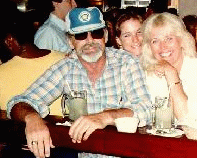update Dec. 12, 2000
For those who know me.
Pucky is gone.
A brief bit History and Personal Philosophy
(for more biographical detail see pdf file below)
One of the wonders of a nuclear explosion that has haunted me from 1954 onward
is the fact that, in all that turbulence and irreversible upheaval, a robust
ring of ionization current, located at the scroll points of the mushroom cloud,
will persist for relatively long periods of time. At the time I had no
explanation, and, although I had been exposed to differential geometry by Dirk
Struik at MIT, I even could not find an analytic formula for the mushroom
shape.
 |
Initially I became interested in trying to find an interaction between
electromagnetism and gravity, for I thought that such an effort would bring me
up to speed in academic rather that programatic research. The idea was to
search for an interaction between the polarization of the electromagnetic field
and gravity.
I quickly learned that the restrictions of tensor analysis to diffeomorphic
sets, and systems governed by metrics, would not solve the problems in which I
was interested. The work of Van Dantzig, who championed the idea that
electromagnetism is not a metrical based theory, greatly intrigued me. When I
had taught myself enough of Cartan's coordinate free methods of exterior
differential forms to formulate electromagnetic theory in terms of topological
properties I intuitively knew that this theory of Cartan had great potential in
the applied world. I used the credence level established by the Cartan methods
to create several inventions involving dual polarized ring lasers. (The Q of
such dual polarized systems exceeds 10^18 !, and they have many applications yet
to be exploited in the real world)
In 1986, an accidental discovery of the Falaco
Solitons greatly influenced my thinking, for here was visual experimental
evidence of topological discontiuties as contained in Cartan's theories.
Moreover, the mushroom signature was evident, and identifiable with a Soliton
Singularity.
The fact that the analytic properties of exterior differential forms
are well behaved not just under coordinate diffeomorphisms, but also for
continuous maps that are not even homeomorphisms, led me to believe that
ultimately these techniques would lead to a non-statistical understanding of
irreversible systems.
That goal has slowly materialized, not completely, but with enough interesting
results to continue to be stimulating. But then in 1997, the concept of
anholomic fluctuations (first formulated about 1986) was used to show that the
Topological Torsion vector on a 2n+2 dimensional symplectic manifold was the
direction field of a thermodynamic irreversible
process. Moreover, this direction field would decay to singular points upon
which the topological dimension would change, forming a contact manifold which
admitted a unique Hamiltonian process. The decay to equilibrium without
statistics could be described with the Cartan methods!
The fundamental premise for me has been to separate out those properties of
physical systems that are of a topological nature from those properties that are
of a geometrical nature. Then to think of how these topological properties
change from initial to final state. Such a procedure would ultimately describe
irreversibility and the aging process.
The initial contribution to topological field
theory was formulated about 1968, with John Pierce, while he visited me at
Los Alamos one summer. My intuition said that there should be an intrinsic
transport theorem lurking in the Cartan methods, and suggested the problem to
John. I came home from work one Friday and John had left me a note about his
efforts for the week. The note said he had given up, and was on his way to
Albuquerque to have a good weekend. I looked at his notes, and as often the
case with me, in an unexplained manner I solved the problem. The fundamental
idea was expressed by the formula
Now more than 30 years later, it has become apparent that starting from a 1-form A of Action potentials on a variety it is possible to deduce a closed charge-current N-1 form, J, by first rescaling the 1-form of Action such that is homogeneous of degree zero in its coefficients, and then computing the Jacobian matrix of the rescaled coefficients, and finally by multiplying the coefficients by the Adjoint of the Jacobian matrix. For a special choice of rescaling (essentially the Gauss map) it follows that the interaction term A^J is equivalent to a function of the curvature invariants of the domain of support. This extraordinary result implies that the source of electromagnetic charge may be a curvature related thing. The formula above now can be interpreted as "the difference between the magnetic and electric energy density is co-homologous to the similarity curvature invariant of degree N-1". The zeros of the Field A^G (which I have named "topological spin") are related to the Euler characteristic of the domain.
Click here for RMK
autobiography